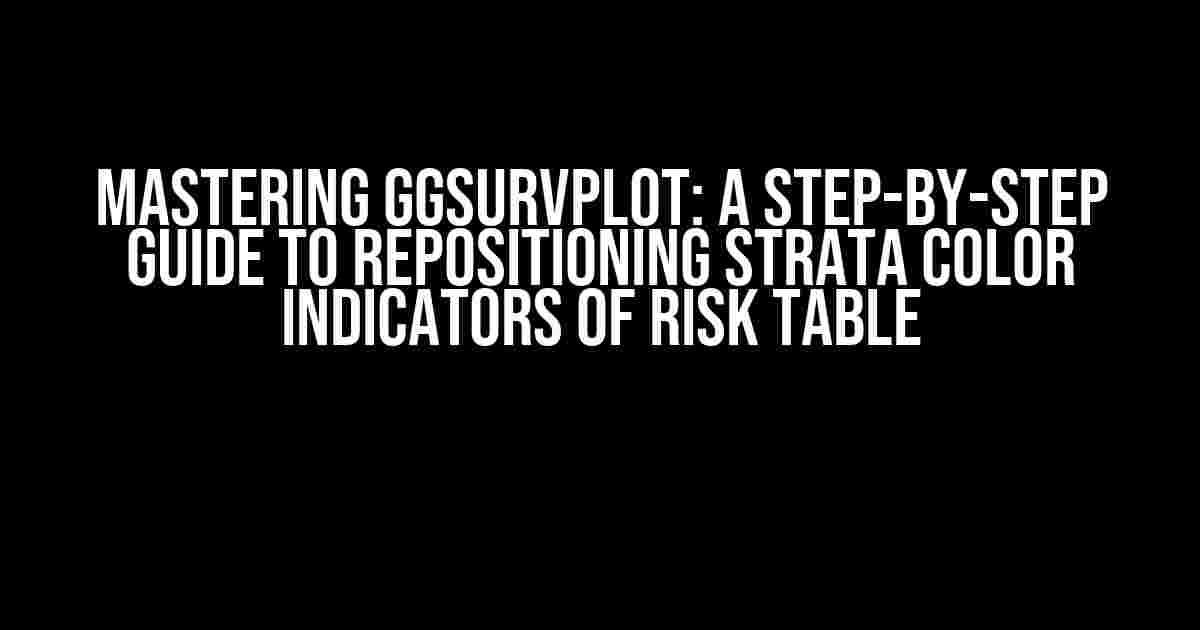Are you tired of dealing with cluttered and confusing survival plots? Do you want to take your ggSurvPlot game to the next level? Look no further! In this comprehensive guide, we’ll walk you through the process of repositioning strata color indicators of risk tables in ggSurvPlot. By the end of this article, you’ll be a pro at creating sleek and informative survival plots that will impress even the most discerning researchers.
What is ggSurvPlot?
Before we dive into the nitty-gritty of repositioning strata color indicators, let’s quickly cover the basics. ggSurvPlot is an R package that provides a convenient way to create survival plots using the ggplot2 framework. It’s an essential tool for researchers and data analysts working with survival data, as it allows for the creation of visually appealing and informative plots that help to identify patterns and trends in the data.
The Problem: Cluttered Strata Color Indicators
One of the biggest challenges when working with ggSurvPlot is dealing with cluttered strata color indicators in the risk table. By default, ggSurvPlot places these indicators at the top of the plot, which can make it difficult to read and interpret the results. But fear not! With a few simple tweaks, you can reposition these indicators to create a more visually appealing and easy-to-read plot.
Step 1: Load the Required Libraries
The first step in repositioning strata color indicators is to load the required libraries. You’ll need to install and load the ggSurvPlot, ggplot2, and survminer packages. You can do this using the following code:
library(ggSurvPlot)
library(ggplot2)
library(survminer)Step 2: Prepare the Data
Next, you’ll need to prepare your data. For this example, we’ll use the built-in lung dataset from the survival package. You can load the data using the following code:
data(lung)Now, let’s create a simple survival plot using ggSurvPlot:
ggSurvPlot(lung, main = "Survival Curve", xlab = "Time", ylab = "Survival Probability")This will create a basic survival plot with strata color indicators at the top of the plot.
Step 3: Reposition the Strata Color Indicators
Now, let’s get to the good stuff! To reposition the strata color indicators, you can use the `legend.position` argument within the `ggSurvPlot()` function. For example, to move the indicators to the bottom of the plot, you can use the following code:
ggSurvPlot(lung, main = "Survival Curve", xlab = "Time", ylab = "Survival Probability",
legend.position = "bottom")This will move the strata color indicators to the bottom of the plot, making it easier to read and interpret the results.
Step 4: Customize the Legend
But wait, there’s more! You can further customize the legend by using the `legend.box` argument. For example, to create a horizontal legend, you can use the following code:
ggSurvPlot(lung, main = "Survival Curve", xlab = "Time", ylab = "Survival Probability",
legend.position = "bottom", legend.box = "horizontal")This will create a horizontal legend that’s easier to read and takes up less space on the plot.
Tips and Tricks
Use Theme Elements to Customize the Plot
One of the best ways to customize your ggSurvPlot is by using theme elements. For example, you can use the `theme_survminer()` function to add a custom theme to your plot:
ggSurvPlot(lung, main = "Survival Curve", xlab = "Time", ylab = "Survival Probability",
legend.position = "bottom", legend.box = "horizontal") +
theme_survminer()This will add a clean and modern theme to your plot, making it easy to read and interpret the results.
Use ggplot2 Functions to Enhance the Plot
Another great way to customize your ggSurvPlot is by using ggplot2 functions. For example, you can use the `labs()` function to add custom labels to your plot:
ggSurvPlot(lung, main = "Survival Curve", xlab = "Time", ylab = "Survival Probability",
legend.position = "bottom", legend.box = "horizontal") +
labs(color = "Risk Group", fill = "Risk Group")This will add custom labels to the color and fill legends, making it easier to interpret the results.
Conclusion
And there you have it! With these simple steps, you can reposition strata color indicators of risk tables in ggSurvPlot and create visually appealing and informative survival plots. By customizing the legend, using theme elements, and leveraging ggplot2 functions, you can take your ggSurvPlot game to the next level and create plots that truly sparkle.
Common Issues and Solutions
Finally, here are some common issues and solutions you may encounter when working with ggSurvPlot:
| Issue | Solution |
|---|---|
| Strata color indicators are not appearing in the legend | Use the legend.title argument to specify the title of the legend |
| The legend is not appearing at the correct position | Use the legend.position argument to specify the position of the legend |
| The legend is not appearing with the correct theme | Use the theme_survminer() function to add a custom theme to the plot |
By following these steps and tips, you’ll be well on your way to creating stunning ggSurvPlots that showcase your data in the best possible light.
Resources
For more information on ggSurvPlot and survival analysis, be sure to check out the following resources:
With these resources and this comprehensive guide, you’ll be well-equipped to tackle even the most complex survival plots and create stunning visualizations that impress.
Frequently Asked Question
Get your queries resolved about ggsurvplot – reposition strata color indicators of risk table!
How do I reposition the strata color indicators in the risk table using ggsurvplot?
You can reposition the strata color indicators by using the `risk.table.colors` argument within the `ggsurvplot` function. For example, `ggsurvplot(Survobj, data = df, risk.table = TRUE, risk.table.colors = “n”)` will move the color indicators to the top of the risk table. You can also specify custom colors using `risk.table.colors = c(“color1”, “color2”, …)`.
What is the default position of the strata color indicators in the risk table?
By default, the strata color indicators are placed at the bottom of the risk table in ggsurvplot.
Can I customize the color palette used for the strata indicators?
Yes, you can customize the color palette by passing a vector of colors to the `risk.table.colors` argument. For example, `ggsurvplot(Survobj, data = df, risk.table = TRUE, risk.table.colors = c(“red”, “blue”, “green”))` will use red, blue, and green for the strata indicators.
How do I remove the strata color indicators from the risk table?
You can remove the strata color indicators by setting `risk.table.colors = NULL`. For example, `ggsurvplot(Survobj, data = df, risk.table = TRUE, risk.table.colors = NULL)`.
Are there any other options available to customize the risk table in ggsurvplot?
Yes, there are several other options available to customize the risk table, such as `risk.table.fontsize`, `risk.table.title`, `risk.table.y.text`, and more. You can refer to the ggsurvplot documentation for the full list of available options.


